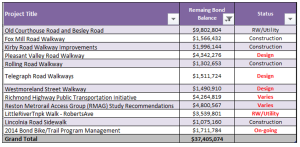During recent Fairfax County budget reviews, the county staff reported that the 2014 $100 million transportation bond referendum had not been fully used. In fact, the county had sold only $52.86 million in bonds to support project expenditures.
The bond referendum was intended to fund 118 bicycle, pedestrian, and spot roadway improvement projects. Of the 118 approved projects, however, only 88 mostly roadway projects (74.6) have been completed. The bulk of the remaining projects focus on pedestrian projects along with an important bike/trail management program.
The staff pointed out that many of the planned pedestrian and bicycle projects required more time to be completed due to the nature of the work and potential need for easements and/or right of way acquisition, coordination with the Virginia Department of Transportation (VDOT), and utility relocation.
The county staff recommended that the Board of Supervisors approve a two-year extension to provide for a full ten-year utilization of the approved funds. They expect that the remaining $47 million will be spent before the bond authorization expires.

This table summarizes the remaining projects larger than $1 million.
The staff reported that typical sidewalk/trail projects can take anywhere from 3-5 years or more to complete depending on complexity. The Fairfax County Department of Transportation, meanwhile, is discussing ways to streamline project delivery with VDOT, which is considering several strategies to give local governments more autonomy in implementing projects.
In FABB’s view, these timelines and the recognized need for streamlining measures argue for more vigorous actions now to move ahead with the county’s master bicycle plan and create truly connected and safe bicycle infrastructure.
- The county also needs to start now to plan for the installation of much needed protected bike lanes.
- In addition, a quick and relatively cost-effective way to improve the county’s bicycling infrastructure would be to add protection—concrete barriers, metal bollards, parked cars, or other barriers—for existing bike lanes.
Streamlining bike infrastructure processes will require more bike advocacy. Want to help? Contact us at [email protected].
